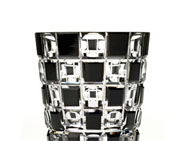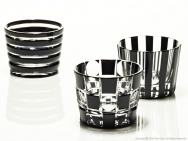Seiichi Kimoto
The 3rd generation proprietor of KIMOTO GLASSWARE Corporation
ABOUT
Seiichi Kimoto is the very upbeat, very energetic third generation owner of the KIMOTO GLASSWARE Corp. During both his grandfather's and father's tenure, the company focused exclusively on the wholesale distribution of glassware. Despite the dwindling Japanese market, and the fact that they had never before produced their own glassware, Kimoto felt that Edo-Kiriko should be preserved in some form and so created 'KIKI Made in TOKYO'.
Tokyo (formerly Edo) has been a leading center of glass production since the Meiji Period (1868-1912). Though at its peak there were a hundred Edo-Kiriko (Tokyo glassware) manufacturers employing a thousand artisans, today only three companies remain with a mere one hundred artisans! A major reason for this steep decline has been the massive influx of cheap Chinese-made glassware with which local manufacturers simply cannot compete. Though so far one of the survivors, KIMOTO GLASSWARE Corp. has been severely affected. Kimoto knew that if he didn't do something, his business would also go under.
Artisans who create items in traditional ways are generally not designers. Their job, their passion, is to maintain time honored traditions by varying their techniques as little as possible, repeating the same processes over and over while passing their knowledge onto the next generation. A noble endeavor, but if things are always done in traditional ways, by default they never change; Kimoto desperately needed to change something.
Working closely with a designer deeply interested in glassware, Kimoto spent 18 months developing the concept of his KiKi black glass idea. He wanted elegance and simplicity with a thoroughly modern feel, but most importantly he wanted the black to be truly charcoal black. This, it turned out, was to be an extremely difficult, time-consuming, expensive, and very frustrating endeavor.
The experiments began. A bowl of clear glass is created over which a second bowl of extremely thin black glass is blown, only tens of microns thick, at a temperature of 1,600 degrees. The freshly blown glass has to be left a week to cool down before the suitability of the color can be assessed. After six attempts and six failures, the artisan was becoming disheartened; each time the black was too purplish, or too reddish. Kimoto encouraged him to persevere and after six months of trial and error on the eighth attempt the elusive charcoal black was finally achieved.
Then came the hard part! While the 'clear' inside and 'colored' outside layer of an Edo-Kiriko glass is usually transparent making any flaws immediately obvious, due to not being able to see through opaque KiKi black glass, cutting is slow and tedious with flaws often passing undetected till work has progressed to an advanced stage. Though a very time-consuming process, the results are absolutely fantastic; a truly unique range of glassware!
Having completely focused his energy and passion for two years quite apart from spending tens of thousands of dollars on development, Kimoto has much pride in KiKi; even after they have been through quality control, he personally checks each glass one last time before placing it in its box for shipment.
Seiichi Kimoto
Products
-
 Black Glass...¥55,920 -转换为其他货币: $ 383.99 USD -
Black Glass...¥55,920 -转换为其他货币: $ 383.99 USD - -
 Black Glass...¥73,560 -转换为其他货币: $ 505.12 USD -
Black Glass...¥73,560 -转换为其他货币: $ 505.12 USD - -
 Black Glass...¥47,100 -转换为其他货币: $ 323.42 USD -
Black Glass...¥47,100 -转换为其他货币: $ 323.42 USD - -
 Jet-Black G...¥9,174 -转换为其他货币: $ 63.00 USD -
Jet-Black G...¥9,174 -转换为其他货币: $ 63.00 USD - -
 Sake Decant...¥13,584转换为其他货币: $93.28 USD
Sake Decant...¥13,584转换为其他货币: $93.28 USD -
 Bordeaux Gl...¥11,820转换为其他货币: $81.16 USD
Bordeaux Gl...¥11,820转换为其他货币: $81.16 USD -
 Guinomi Gla...¥38,280 -转换为其他货币: $ 262.86 USD -
Guinomi Gla...¥38,280 -转换为其他货币: $ 262.86 USD - -
 Sake Glass ...¥8,292转换为其他货币: $56.94 USD
Sake Glass ...¥8,292转换为其他货币: $56.94 USD -
 Ultra-Thin ...¥20,640转换为其他货币: $141.73 USD
Ultra-Thin ...¥20,640转换为其他货币: $141.73 USD